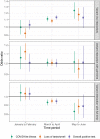In-person schooling and associated COVID-19 risk in the United States over spring semester 2021
- PMID: 35442740
- PMCID: PMC9020776
- DOI: 10.1126/sciadv.abm9128
In-person schooling and associated COVID-19 risk in the United States over spring semester 2021
Abstract
Because of the importance of schools to childhood development, the relationship between in-person schooling and COVID-19 risk has been one of the most important questions of this pandemic. Previous work in the United States during winter 2020-2021 showed that in-person schooling carried some risk for household members and that mitigation measures reduced this risk. Schooling and the COVID-19 landscape changed radically over spring semester 2021. Here, we use data from a massive online survey to characterize changes in in-person schooling behavior and associated risks over that period. We find increases in in-person schooling and reductions in mitigations over time. In-person schooling is associated with increased reporting of COVID-19 outcomes even among vaccinated individuals (although the absolute risk among the vaccinated is greatly reduced). Vaccinated teachers working outside the home were less likely to report COVID-19-related outcomes than unvaccinated teachers working exclusively from home. Adequate mitigation measures appear to eliminate the excess risk associated with in-person schooling.
Figures









References
-
- “Map: Where were schools required to be open for the 2020-21 school year?,” Education Week, 28 July 2020; www.edweek.org/leadership/map-where-are-schools-closed/2020/07.
-
- WHO, WHO coronavirus (COVID-19) dashboard; access date: 11 September 2021, https://covid19.who.int.
-
- Centers for Disease Control and Prevention (CDC), COVID data tracker (CDC, 2020); https://covid.cdc.gov/covid-data-tracker.
-
- MCH Strategic Data, COVID-19 IMPACT: School district operational status; access date: 11 September 2021, https://mchstrategicdata.maps.arcgis.com/apps/MapSeries/index.html?appid....
-
- Viner R. M., Mytton O. T., Bonell C., Melendez-Torres G. J., Ward J., Hudson L., Waddington C., Thomas J., Russell S., van der Klis F., Koirala A., Ladhani S., Panovska-Griffiths J., Davies N. G., Booy R., Eggo R. M., Susceptibility to SARS-CoV-2 infection among children and adolescents compared with adults: A systematic review and meta-analysis. JAMA Pediatr. 175, 143–156 (2021). - PMC - PubMed
LinkOut - more resources
Full Text Sources

